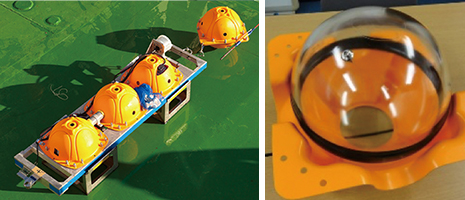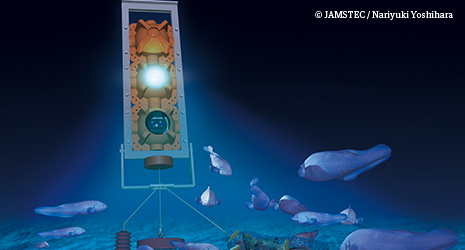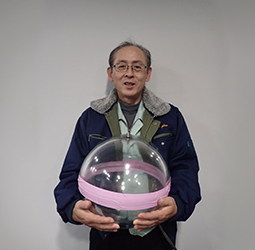Home > Highlighting JAPAN >Highlighting Japan March 2016>Science & Technology
Highlighting JAPAN


A Clear Look into the Depths
Okamoto Glass, which built a glass sphere that can withstand pressure of 800 atm for the Edokko-1, an unmanned submersible developed with various Japanese small and medium enterprises, has successfully developed a glass sphere capable of enduring 1,200 atm, equivalent to the crushing force of the fullest depths of the sea.
Okamoto Glass designs and produces specialized glass items, starting from glass parts for lighting fixtures such as traffic signal light bulb covers and automobile lights, and advancing all the way to cutting-edge optical filters and multilayer films for fiber optics. The company holds the global market’s top share for dental mirrors and reflecting mirrors for projectors, and is at the forefront of the industry with its many years of expertise and sophisticated craftsmanship.
In 2012, Okamoto Glass demonstrated its true strength by taking on a new challenge: the development of the Edokko-1 unmanned submersible. The project brought together the specialized skills and technologies of various Japanese small and medium enterprises. Okamoto Glass was tasked with devising a glass housing that could withstand deep-sea pressures—the core of the vehicle.
The Edokko-1 submersible craft consists of three glass spheres. Inside each sphere are, respectively, a light fixture designed to illuminate the pitch-black depths, a video camera, and battery units that power the first two. The Edokko-1 is then outfitted with weights and allowed to descend to the ocean floor; after it observes its surroundings, the weights are released and the craft floats back to the surface.
Originally, the glass spheres for the Edokko-1 were to be sourced from a German or American manufacturer, since at the time only two companies were crafting such globes for deep-sea exploration. This meant the Edokko-1 would not be 100 percent “made in Japan.” There seemed to be no way past the impasse until Okamoto Glass suddenly stepped in, confident that they could make the spheres. The craft was slated to submerge to a depth of 8,000 meters where it would be subjected to 800 atm of pressure, so Okamoto had their work cut out for them.
“In recent years, many glass manufacturers have been falling fast as their products were edged out by plastic, which is comparatively lighter, less expensive and easier to machine,” says Ryuji Toyoyama, a Maritime and Special Projects Division representative at the company. “However, plastic is utterly incapable of withstanding 800 atm of pressure. Glass is also exceptionally more cost-effective than materials like ceramics and titanium, and can withstand the crushing force of the deep sea.”
All the same, the company had never worked with maritime products or ever been requested to make a product with that level of pressure tolerance. Okamoto obtained used glass spheres from Germany and the U.S. and examined them. By thoroughly analyzing the nature of the damage those spheres had sustained, they were able to use the resulting data to develop a more resilient globe, which they subjected to a series of pressure-resistance trials. The Japan Agency for Marine-Earth Science and Technology (JAMSTEC) helped Okamoto obtain much-needed simulation and analytics technologies.
Glass spheres are built by fusing two halves together. Okamoto Glass discovered that the seam, colloquially referred to as the “equator,” was the only part that split when sustaining damage. They thus narrowed their focus to designing a sphere with a resilient equator that would withstand enormous pressure. In August 2013, sixteen months after joining the project, they had crafted a sphere capable of withstanding 800 atm of pressure. In November of the same year, one Edokko-1 device descended 4,000 meters into the Japan Trench, and two more descended to 7,800 meters, all returning safely.
Having cleared that technical hurdle, the next step for Okamoto Glass is building spheres that can plunge to the 10,911-meter depths of the Mariana Trench’s Challenger Deep, or what is known as “full depth”—the deepest point on Earth. In November 2015, the company successfully built a thirteen-inch (32-centimeter diameter) globe that can withstand up to 1,200 atm of pressure, and it passed pressure tests conducted at JAMSTEC.
Okamoto Glass is now investigating the prospect of bringing this technology to the world, and will be exhibiting its wares at various maritime events and conventions. Of course one of the company’s goals is to make a sphere capable of full-depth submersion, but as Toyoyama notes, “A globe that can withstand 1,200 atm of pressure has applications far beyond just marine exploration, so we want to explore the possibilities of this untapped field.”
© 2009 Cabinet Office, Government of Japan







